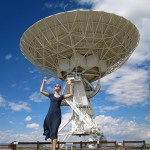Telescopes
The European Southern Observatory made major headlines with their discovery of an Earth-like exoplanet orbiting our nearest neighboring star. On Dynamics of Cats, Steinn Sigurðsson writes: "ESO researchers, using the radial velocity variability technique, have detected a quite robust signature of a planet with a mass of 1.3 Earth masses, or more, in a 11 day orbit around Proxima Centauri." The planet is within the red dwarf's habitability zone, but we don't yet know if it harbors an atmosphere or liquid water. Greg Laden writes "now that we have an Earth-like planet in our sights, perhaps…
Is this science writer jazzed that ninth-grade girls from a religious girls’ school in Jerusalem won a space/science contest? You bet your sweet solar-powered spacelab she is! It is not just that these girls beat out a lot of other classes (over 400), or that they break more than one stereotype. They also came up with a pretty clever idea for studying the Sun: Send a spacecraft to scatter assorted nanolabs all over an asteroid that is about to pass close to the Earth on its way to the Sun. The contest is held every year in memory of Israeli astronaut Ilan Ramon, who went down with the crew of…
On Starts With a Bang, Ethan Siegel makes headway on his tour of "110 spectacular deep-sky objects" first cataloged by Charles Messier in 1758. Before powerful telescopes were developed, the heavens consisted of the sun, moon, stars, a few bright planets, and the rare passing comet. Comets were actively sought by men like Messier, who one night saw a bright smudge—too ill-defined to be a star—that "neither brightened nor changed position nor altered in appearance over the subsequent nights." He had spotted the beautiful Crab Nebula, an expanding lacework of stardust blown…
On Starts With a Bang, Ethan Siegel investigates the hamstringing of the James Webb Space Telescope. Originally scheduled to launch in 2013 at a cost of $5.1 billion, the JWST was pushed to 2015 and $6.5 billion by a government review panel that faulted NASA mismanagement. But the revised numbers counted on timely infusions of cash, and because "a miserly US Congress" withheld them, the cost of the project ballooned to $8.7 billion, with a new launch date of 2018. Although its unprecedented mirrors are nearly finished—along with its electrical instruments and their housing—the JWST still…
The service tower attached to the iconic floating egg atop the Institute's Koffler accelerator (the "spaceship" in the photo, left) has recently been graced with a charming, shiny silver skullcap - an observatory dome. Formally known as the Martin Kraar Observatory, it houses two telescopes, and it figured in two of our recent press items. We spoke with observatory director Ilan Manulis of the Davidson Institute of Science Education:
WSW: Tell us about the telescopes.
IM: The larger one is a 41 cm. (16 in.) telescope. Due to special optical properties, it has the power of a much longer…
"All things move and nothing remains still" -- Heraclitus
The history of astronomy can be read as a story of better and better vision. Over the centuries, we have supplemented our vision with technology that allows us to see further and more clearly; while Ancient astronomers, who relied only on their naked eyes to perceive the universe, managed to make star catalogues and predict comets, Galileo, pressing his to a telescope, saw all the way to the moons of Jupiter.
Optical telescopes and the human eye are fundamentally limited; early astronomers were forced to gaze into telescopes for…
The author, dishing.
To get to the National Radio Telescope Observatory, you have to be committed.
Well, first, you have to be in New Mexico -- about an hour's drive south of Albuquerque, in the plains of San Augustin, to be precise, a Pleistocene lakebed bordered by the northern end of the Chihuahuan Desert and dotted with arid shrubs. Despite being some 6,970 feet above sea level, it feels like the basement of the world, wide and flat and under the massive Southwestern sky. Driving to the Observatory, the home of the famous "Very Large Array" of radio telescopes, is an exercise in…



